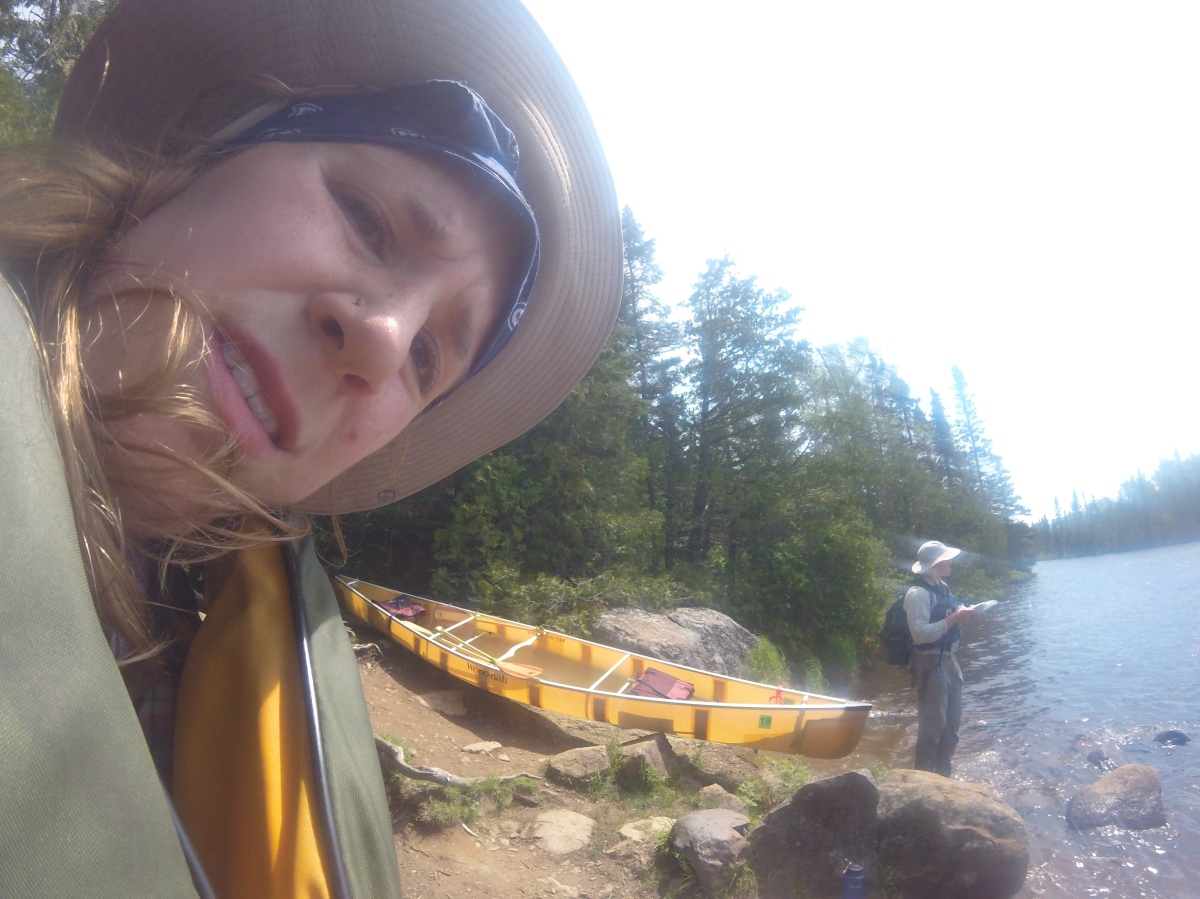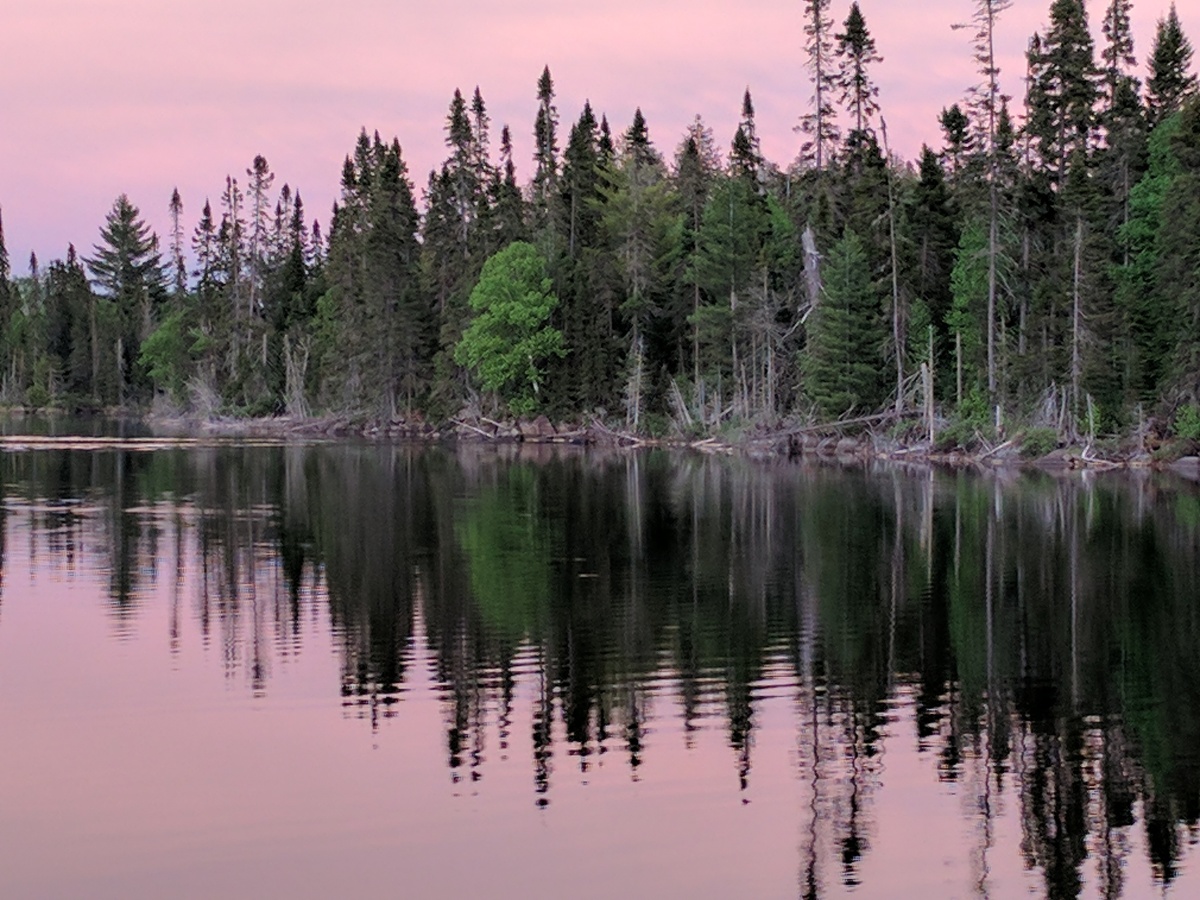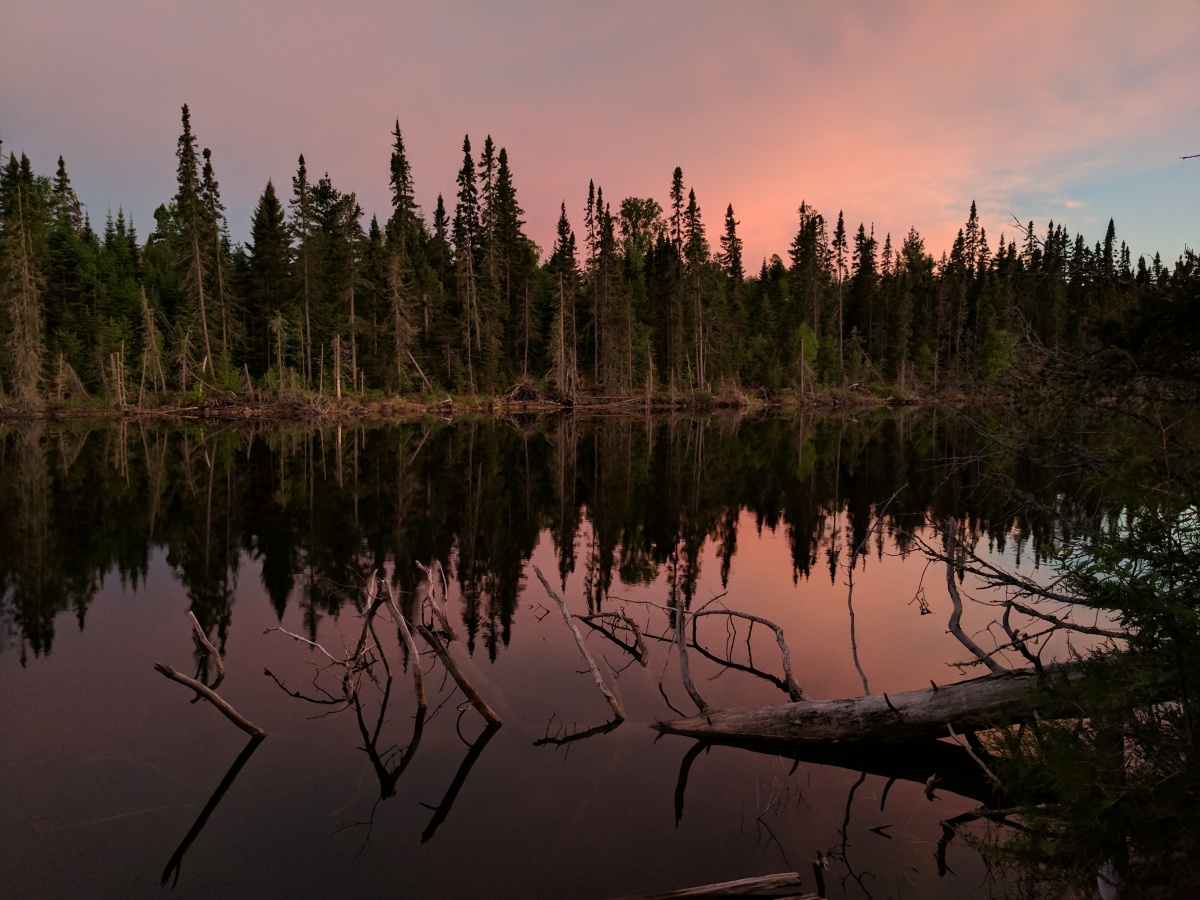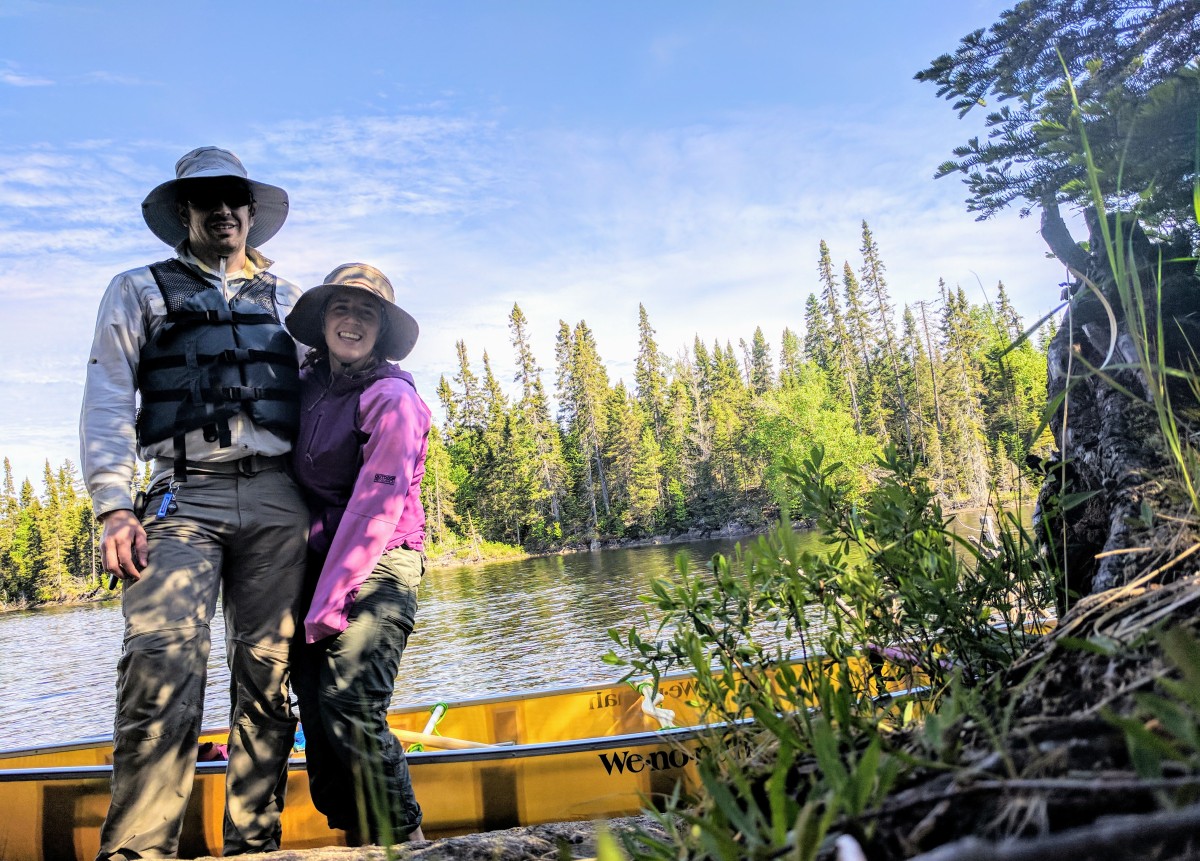This page contains affiliate links. Read our complete disclosure here.
Portages through the rocks and mud, paddling through the wind and catching fresh fish to be cooked on hot stone rocks over a campfire that’s what the Boundary Waters Canoe Area Wilderness is about.



We went on a 4 day/3 night Boundary Waters trip. It was our first time there and for first timers, this was the perfect length of time to spend on this type of trip. Paddling, portaging and setting up camp becomes tiring on day 3. We started the trip out at entry point 47: Lizz and Swamp Lakes.
If you’ve never portaged before, the first portage is the hardest (mentally and physically). It’s what prepares you for what’s to come. How else can you prepare yourself to carry a canoe overhead while watching your foot placement between rocks, sticks and slippery mudslides? We had been to a couple of workshops about the Boundary Waters Canoe Area Wilderness (BWCAW) provided by some outdoor recreation stores around us so we thought we knew what to expect at a portage, but experience, that is where most lessons are learned (that goes for everything in life).
Lesson #1: Minimize the amount of items to carry. Avoid small items. We made the mistake of carrying 3 small bags in addition to our large portage pack and of course the canoe.



Lesson #2: Have a way to connect paddles to the canoe. We were fortunate enough to be at our first portage with a group who was on their final portage out, so they passed their paddle connectors on to us. These connectors were basically giant, robust twist ties. Others have used bungees to hold paddles to the canoe during portages. Whatever you choose, these will be life savers to you! Instead of awkwardly carrying the paddle through each portage, simply connect them to your canoe; it’s a much smoother portage that way.
To the person from Virginia, MN who passed those on to us… we can’t thank you enough! It felt like what I’d imagine “thru hiker” culture is like, everyone out there is willing to support one another in any way they can. There is an intimate connection you develop with your surroundings, including people, when you immerse yourself into a remote setting.
Lesson #3: Use portage pads. We highly recommend portage pads to ease the tension on your shoulders when carrying canoe overhead. We didn’t have these so Andy made do with an extra shirt for a couple of portages.


Lesson #4: If you have a canoe seat for extra cushion, make sure it attached securely before you portage. This way it doesn’t obstruct your vision halfway thru portage. We forgot to attach it securely and Andy had to holler ahead for me to take the seat off mid portage so he could see. (Even though the only thing in sight is the canoe).


After lessons learned, we were able to get a system down for portaging the remainder of the trip. My job on the portages was the big pack, food pack and cooler. Andy’s job was Camelbak day pack and canoe.
On shorter portages, we were able to leave everything in the canoe (except the big portage pack which weighs about 50 pounds) and carried the canoe together instead of Andy solo carrying overhead. This worked well for the 15-rod or shorter portages (1 rod = 16.5 feet). Taking all of the gear in and out for such a quick portage didn’t seem strategic. You’d spend more time loading the canoe and yourself with the stuff than it would take to walk across the portage.
Day 1 was a total of 6 portages taking us through 6 different lakes, a couple of those were very brief. We started out on Poplar Lake and made our way to the entry point on Lizz Lake. From Lizz, we portaged to Caribou Lake and paddled south for a very short portage to Horseshoe Lake. We came to a crossroads at Horseshoe, there were two ways to get to Gaskin Lake where we intended to camp: 1) Paddle south to a longer 97-rod portage, or 2) Paddle west to 3 shorter portages (57-rod, 16-rod, and 19-rod). Already tired and sore from the first day, we chose the latter to break things up and give ourselves small breaks from carrying everything. Going this route also allowed us to paddle through some lesser traveled lakes in the area, Allen and Jump Lakes, before finally reaching Gaskin Lake.



Our first campsite was on Gaskin Lake. It was a windy day, so this made for a windy campsite. This meant no campfire for the evening (although ranger Andy always tries.) Note: be sure to check for fire restrictions/regulations when getting your permit for BWCAW. Sometimes there is a fire ban due to dry conditions.

Setting a tent up in wind is a challenge… but not nearly as challenging as paddling in the wind. To have a more “enjoyable” and less windy dinner, we decided to cook away from the campsite and walk inland more away from the windy shoreline. This made for less wind and enforces the “cook at least 100 feet away from your sleeping area” rule.


Day 2 was a total of 3 portages and 3 lakes. We got off to an early start of paddling at 8:30 AM. Paddling early is recommended to avoid the high winds in the afternoon. The water is significantly calmer in the mornings. We paddled west from our campsite and then south into a narrow bay to reach a 58-rod portage to Winchell Lake. We paddled west through Winchell Lake which turned into a rainy paddle. Winchell is a long lake so it’s a good thing we brought heavy duty rain gear.


The good thing about paddling on a rainy lake? It invites the moose out… marshy areas with cooler climates make for perfect moose habitat. To our pleasant surprise we saw three moose as we paddled down Winchell Lake.


One moose was alone and the other was a mother moose with its baby. The mother moose was protecting her baby and had her eyes close on our every move. I was so excited to see a moose but I couldn’t bring myself to look straight enough at it to take a photo… I was scared it may charge in protection of its young. I told Andy we had to paddle farther out to the middle of the lake. Wildlife is a gift to see but be sure to enjoy it from a safe distance.
From Winchell Lake, we portaged north to Omega Lake along a 50-rod portage. We started looping back to our entry point on Lizz Lake at this point so we paddled northeast to a 37-rod portage that took us to Henson Lake where we planned to camp for the night.


After paddling we setup camp for the evening. We declared this site to be named “Turtle campsite” because it was a sun bathing haven for turtles. Once camp was setup, we went fishing in the early evening. Andy caught two northern pike, which that particular lake is known for. Each lake in the BWCAW has certain fish its known for. Make sure to check the various fish species along your route before you go so you can plan your campfire fish dinner ; )


When we came back to our campsite, there were two turtles sun bathing near our campfire grate. Later on, more turtles appeared on the shoreline by our site. If we were quiet enough the turtles came back to the campsite close enough for us to get a good look. If you have a love for hard-shell creatures, this is the campsite for you!







Day 3 began on Henson Lake with the first portage 53 rods to Pillsbury Lake. We had a short paddle to the next portage of 93 rods. Instead of trekking the longer 90+ rod portage right away, we tried to take a shortcut through a marshy channel. As we took that shortcut I thought about the news story before we left for our Boundary Waters trip. It was about a couple who got lost taking a shortcut, but we paddled on. We learned from the “shortcut” we tried, that portages exist for obvious reasons. We took on the challenge and successfully paddled through the first 1/4 mile of marsh/swamp but then we ran into large downed trees that we couldn’t pass with an 18-foot canoe. We decided that was the end, and turned around to head back to where we came from… the actual mapped out route.


My suggestion if you want to avoid a long portage? Just do the portage. You’ll save time and energy. Although the adventure of the unknown shortcut is a rush… especially if it’s your first time in BWCAW, be safe and portage.
When we returned to the lake we had a bit of trouble finding the portage. After about an hour combing the shoreline for the portage, Andy was about to give up and plan a different route back. We decided to make one last attempt at finding the portage and paddled further into a small bay that was past where the map showed the portage. Finally, we found the portage we’d been looking for in that little bay! We were relieved but at the same time, a bit frustrated that we didn’t explore this area sooner.

The portage we were desperately searching for previously was 93 rods and brought us to a small, narrow lake called Swallow Lake. The next portage was a stone’s throw away on the opposite shore. If the lake wasn’t so deep, Andy would have waded the canoe over to the next portage. The lake dropped off steeply though from the shoreline and if we weren’t careful getting into our canoe we would have found ourselves in chest high water. After a couple paddle strokes, we found ourselves at our longest portage of the trip, 110 rods. We decided to take all of our gear and the canoe at once instead of making two trips. It was fortunate for us that it was a relatively flat portage, so even though it was our longest portage, it was not the hardest of the trip.
We finally made it to Meeds Lake which hosts our most anticipated campsite of our trip. We got to our island campsite on Meeds Lake just before 1 PM. Paddling in the morning is strongly encouraged because as we paddled at high noon, rough winds were coming over us. The effort spent paddling in the wind made a freshly caught bass fish dinner even more satisfying that evening. We didn’t have any tin foil so we cooked the fish on hot stones over the campfire. A true Boundary Waters meal! Just be sure to throw your rocks away from your campsite after so the critters don’t come for the fish leftovers! Another important procedure to follow: after cleaning the fish, properly dispose of the waste. Walk the fish far away from your campsite and leave it to decompose (or be eaten by critters). This is also BWCAW regulations. They don’t want you to throw the fish back in the lake, as it will pollute the water. So be sure to walk the fish remains far enough away from your site so you don’t attract critters close to camp; backcountry camping basics.



We only saw one other person the whole day/evening spent on Meeds Lake. The paddler had a system down to fish and solo canoe at the same time… and he was successfully catching fish! Andy has now set this as a “Boundary Waters goal” for himself.


Day 4 involved portaging from Meeds Lake to Caribou, then to Lizz and finally to Poplar where we retrieved the car. We made our drive back with a stop in Grand Marais for some donuts, pizza, and beer before making the long drive back to the Twin Cities.


We are already dreaming about our next trip to this well-preserved gem we have in Minnesota/Canada. We hope to find more of the less traveled parts of the BWCAW. We ran into very few people this time and to be truly removed from the day to day human interactions and secluded in the wilderness for 4 days is an experience like none other. To know that people go to BWCAW for 2 weeks at a time solo is motivating/inspirational…. to know that others have the same struggles we did but were solo! That is a whole other level. I give you solo canoers huge props! It’s a challenge not all would desire to conquer.
We need to remind ourselves how great it is to have this land so near to us, a simple 5-hour drive from the Twin Cities (maybe 5 1/2 hours if you stop at World’s Best Donuts in Grand Marais!).


Enjoy the start to your summers. The season will be gone before we know it, so get out and take advantage of every moment.


Our question to readers: What areas of the BWCAW would you recommended to us and why?

Peace, love, and hike thru life!
Sarah and Andy
Love this and your guys enthusiasm! Boundary Waters has been on my bucketlist for awhile thanks for all the insight.
Thanks Jessica! It really is a magical place to go!
Great write up of your adventures !! Love hearing about them and seeing your pics !! Can’t wait to hear about your next adventute !🚗
🚣⛺️💕
Enjoyed reading about trip. Beautiful pictures. Wish you had closer pictures of the moose.!, Liked picture of camp where you had clothes hanging on line..also picture of cooking on hot stone.great that you attended classes on portage so you knew how to meet the many challenges you faced..You did so well to accomplish this trip. Congratulations! Well done!! Very well written..🤗😘😧💞pjm
Loved reading about your adventures through the boundary waters! What an experience for you!
Thanks for sharing all your ventures.